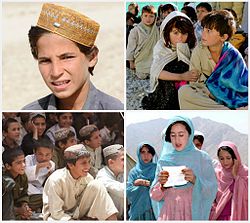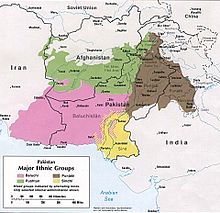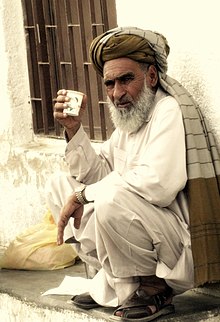Type a search term to find related articles by LIMS subject matter experts gathered from the most trusted and dynamic collaboration tools in the laboratory informatics industry.
| Regions with significant populations | |
|---|---|
| 578,315 (2021)[1] | |
| 138,554 (2021) (Estimate)[2] | |
| 260,577 (2018)[3] | |
| 200,000 (2015)[4] | |
| 150,800 (2021)[5] | |
| 169,000 (2022)[6] | |
| 81,154 (2021)[7] | |
| 60,590 (2018)[8][verification needed] | |
| 19,800 (2015)[9] | |
| 5,500 (2008)[6] | |
| 500,000(estimate) | |
| 152,000(2021) | |
| Languages | |
| Pashto, Dari Persian, Hindko, Urdu-Hindi, English | |
| Religion | |
| Majority: Sunni Islam Minority: Shia Islam, Hinduism,[10] Sikhism[11] | |
Pashtun diaspora (Pashto: بهر میشت پښتانه) comprises all ethnic Pashtuns. There are millions of Pashtuns who are living outside of their traditional homeland of Pashtunistan, a historic region that is today situated over parts of Afghanistan and Pakistan.[12] While the (erstwhile) Pashtunistan is home to the majority of Pashtun people, there are significant local Pashtun diaspora communities scattered across the neighbouring Pakistani provinces of Sindh and Punjab, particularly in their respective provincial capital cities of Karachi and Lahore. Additionally, people with Pashtun ancestry are also found across India; particularly in Rohilkhand, a region in the Indian state of Uttar Pradesh; and in the Indian states of Gujarat and Rajasthan. Outside of South Asia, significant Pashtun diaspora communities are found in the Arab states of the Persian Gulf (primarily in the United Arab Emirates), the United States, the United Kingdom, Netherlands, Iran, Australia, Canada, and Russia.
The Pashtun people, who are classified as an Iranian ethnolinguistic group, are believed to have settled in the traditional Pashtunistan region around the early 1st millennium CE.[13][14] According to Ethnologue, the total Pashtun population currently stands at around 30 million,[15] but some sources give slightly lower or higher figures. Among Indic communities in the Indian subcontinent, Pashtuns are commonly referred to by the word Pathan.

The ethnonym Afghan (of Persian origin) has been historically used since the 3rd century AD to refer to the Pashtuns, and is now used to describe every citizen of Afghanistan. Pashtuns make up the largest ethnic group in Afghanistan, comprising 46-65%[16][17] of the total Afghan population. Approximately 2 million Afghan refugees live in the neighboring Pakistan. The majority of them are Pashtuns who were born in that country.[18]
The Pashtuns are scattered all over Afghanistan, they can be found in almost every province of the country.[19] Kandahar is the second largest city in Afghanistan and a stronghold of the Pashtun culture. The city of Lashkargah in the south, Farah in the west, Jalalabad in the east, and Kunduz in the north are other prominent cultural centres whose populations are predominantly Pashtuns.


Most Pashtuns are based in Pakistan. Pashtuns are one of the largest ethnic minorities in Pakistan, making up to 18% of the total population of Pakistan.[20][21] Pashtuns form the majority ethnic group in the province of Khyber Pakhtunkhwa and northern Balochistan.
With as many as 7 million by some estimates, the city of Karachi in the Sindh province hosts the largest concentration of urban Pashtuns population in the world[22][23] Some important Pashtun cities of Pakistan include Peshawar, Quetta, Zhob, Loralai, Killa Saifullah, Attock, Swat, Mardan, Charsada, Mingora, Bannu, Parachinar, and Swabi. The province of Baluchistan is although named after the Baloch, but Pashtuns are the majority there and the Baloch population is in fact less than Pashtuns in the Balochistan province.[citation needed] However most of the land of Baluchistan is covered by Balochs and Brahuis while Pashtuns are concentrated only in the north of the province.
Pashtuns make up a minority of the total population of Hazara Division of Khyber Pakhtunkhwa.[24] Pashtuns are mostly found In Battagram and Torghar District, Pashtun tribes speak Pashto language while Jadoons, Tareens and Dilazaks of Abbottabad & Haripur District speak Hindko language and sometimes Pashto as their second language. Pashtuns also make up a minority of the Chitral district, which is mainly inhibated by Kho and Kalasha people who speak Khowar.
The following table outlines the Pashtun population in different provinces of Pakistan:
| Province | Pashtuns |
|---|---|
| 30-32 million (as per 2017 population census of Pakistan) | |
| 7 million[22] | |
| 3.5 million [citation needed] | |
| 2.3 million [citation needed] | |
| 350,000 [citation needed] | |
| 450,000 [citation needed] | |
| 56.7[20][21] |
Smaller Pashtun communities outside Khyber Pakhtunkhwa and Balochistan can be found in the districts of Attock and Mianwali in the Punjab Province. These and other communities of Pashtun ancestry who have long-settled in Punjab and Sindh region are often referred to as the Pathans. There are also large communities of Pathans such as Niazi and others who live in Khanewal, Kasur areas of Punjab, and the Multan area, which was formerly a part of the Durrani Empire. Pathan communities live in different district of Azad Kashmir too. There, they are mainly settled in the districts of Poonch, Sudhnuti and Bagh. In Poonch and Sudhnuti they constitute more than 70% of the population. Kashmiri Pashtuns mainly consist of the Sadozai tribe, which is locally known as Sudhan. Approximate population of Sadozais in AJK is 1 million. Sadozai tribe has a strong hold in the Rawalakot city of Azad Kashmir. A small number of other Pashtun tribes in Kashmir include Durrani, Tareen, Lodhi, Yousafzai, Shinwari and Afridi tribes, whose populations extend from Azad Kashmir to India's Jammu and Kashmir. They speak local languages.[citation needed]
In addition to this, some Urdu-speaking communities in Pakistan also trace their ancestry to the ancient Pashtun regions of Afghanistan and Khyber Pakhtunkhawa.[citation needed] Some identify themselves as Bangash, Yusufzai, Ghouri and Durrani. Moreover, a significant number of descendants of Rohillas had migrated to Pakistan after the partition of India, in 1947. The Pashtuns make up 30% of the Muhajir community in Karachi.
| Part of a series on |
| Pashtuns |
|---|
| Empires and dynasties |
In India's Rohilkhand region, Pashtuns had made large settlements between 14th century and 20th century. In fact, according to the 1911 edition of Encyclopædia Britannica, the number of Pashtuns in the British India was nearly 3.5 million, but the speakers of Pashto numbered less than 1.25 million.[25] Most of this population were allotted, along with their respective provinces, to Pakistan after the partition of India, in 1947.[citation needed] Today, the Pashtuns in India can be divided into those who speak Pashto and those who speak Urdu/Hindi and other regional languages. However, the Pashtuns speaking Urdu/Hindi are in majority the.[26] Khan Mohammad Atif, a professor at the University of Lucknow, estimates that "The population of Pathans in India is twice their population in Afghanistan".[27]

There are many Pashto-speaking Pakhtuns in the Indian state of Jammu and Kashmir.[28] Although their exact numbers are hard to determine, they are at least more than 100,000, for it is known that in 1954, over 100,000 nomadic Pakhtuns living in Kashmir Valley were granted Indian citizenship.[29] They still follow their traditional justice system of Jirga.[30] Those settled and living in the Kashmir Valley speak Pashto, and are found chiefly in the southwest of the valley, where Pashtun colonies have been built over time. The most interesting are the Kukikhel Afridis of Dramghaihama, who retain all the old customs and speak Pashto. They wear colorful dresses and carry swords and shields. The Afridis and the Machipurians, who belong to the Yusufzai tribe, are liable to military service, in return for which they hold certain villages free of revenue. The Pashtuns chiefly came in under the Durranis, but many were brought by Maharajah Gulab Singh for service on the frontier.[31] Pashto is also spoken in two villages, Dhakki and Changnar (Chaknot), located on the Line of Control in Kupwara District.[32] In response to demand by the Pashtun community living in the state, Kashir TV has recently launched a series of Pushto-language programs.[33]
A further small, scattered Pashtun population still exists in some major cities of India with large Muslim populations, with the majority of Pashto-speaking individuals residing in the states of Delhi and Uttar Pradesh India; who also have adopted local languages of the respective areas they live in, as their second language.[34] These Pathans, numbering around 14,161,[35][36] have retained the use of the Pashto language and are still able to speak and understand it. This is partially because until recently, most of these Indian Pashtuns were able to travel to Pakhtunkhwa, Pakistan.[37]
A small Hindu community, known as the Sheen Khalai meaning 'blue skinned' (referring to the color of Pashtun women's facial tattoos), migrated to Unniara, Rajasthan, India after partition.[38] Prior to 1947, the community resided in the Quetta, Loralai and Maikhter regions of the British Indian province of Baluchistan.[38] Today, they continue to speak Pashto and celebrate Pashtun culture through the Attan dance.[38]
The larger number of people claiming Pashtun ancestry in India are Urdu speaking. Despite the loss of most of the Raj-era Pashtun population, India still has a community of Hindustani speakers who can trace some of their ancestry to ancient Pashtun settlers. They are often referred by the Hindustani pronunciation of the word Pashtun, "Pathan".
Major Indian Pathan tribes lived in the following areas. While many persons belonging to these tribes moved to the Afghan-Pakistan border, others chose to stay and thus, descendants of these tribes still reside in the parts of India listed below:[39] There are major Pashtun settlements in Saharanpur, Farrukhabad, Bihar and Kolkota.[40]

Hundreds of thousands of Pashtuns serving as migrant workers reside in the Middle East, particularly in the United Arab Emirates, Saudi Arabia, Qatar, Kuwait, Oman and other Arab countries.[41] Many of them are involved in the transport business, while others are employees of construction companies.
There were over 100,000 Pashtuns living in Iran in 1993. The Pashtuns there are mainly concentrated in the Afghan-Iran border, in the Khorasan Province of Iran.[6] The settling of Pashtuns in Iran goes back to the 18th century during the Durrani reign. Timur Shah Durrani, an ethnic Pashtun, the son of Ahmad Shah Durrani and King of Afghanistan, was born in Mashhad, in the Khorasan province of Iran, which was part of the Durrani empire at that time.[42]
About 300,000 Pashtuns migrated to the Persian Gulf countries between 1976 and 1981, representing 35% of Pakistani immigrants.[41]
Many Pashtuns have migrated from their homeland in South/Central Asia to Europe.[citation needed]
The United Kingdom is home to some 100,000 Pashtuns,[43] making it one of the most populous overseas Pashtun communities in the world and the most populous one in the West. Pashtun diaspora in UK have made their presence felt through their restaurants with traditional names like Bab-eKhyber, Hujra, Kabuli pulao etc. and Music. Its one of the most vibrant Pashtun diaspora in the west.[44]

Pashtuns have been present in California at least since agricultural labor was imported in the early 20th century. Since the late 1970s and onwards, Pashtuns began immigrating to the USA in large numbers and are well established there. Pashtuns in the United States are famous for running top Afghan cuisine restaurants[45][46][47] and as owners of the fast-food restaurant chain Kennedy Fried Chicken that is based in New York City.
1,690 persons characterized their ethnicity as "Pashtun" in Canada's 2006 census.[48] However, in question 17 of Canada's Statcan census form[49] most Pashtuns don't put their ethnicity as Pashtuns but rather Afghan or Pakistani.
In the latter part of the 19th century several thousand men from Afghanistan, Baluchistan, Kashmir, Sind, Rajasthan, Egypt, Persia, Turkey and Punjab, but collectively known as "Afghans", were recruited during the initial British development of the Australian Outback, especially for the operation of camel trains in desert areas.[50] These consisted of men who were not allowed to bring their families with them, many married local Aborigines and are now known as Ghans.[51] During the 1980s and 90s, Pashtuns began settling in Perth, Melbourne, Sydney and other major cities of Australia.
Pashtuns in Bangladesh are descendants of Pashtun emigrants who settled into Bangladesh during the Pathan rule of the Bengal Sultanate under the Karrani dynasty.[52] Additional Pashtun communities of South Asia are also the Pathans of Sri Lanka, who are believed to have origins from Pathans who settled in Batticaloa, initially arriving for trade.[53]
Since the early 1900s there have been many generations of Pashtuns who migrated from Afghanistan and the tribal areas of Pakistan (Khyber Pakhtunkhwa). Pashtun settlements in Thailand have been common throughout the provinces. There is even a Thai-Pashtun Friendship Association and they are fiercely independent, as a result they often are well treated and respected by the Thai locals. Countries like Indonesia, Singapore, Brunei and Malaysia, Myanmar also have similar cases of Pashtun settlements, which those who are of descent are quickly assimilated to the local Indian ethnic minority community while those recent migrants or settlers belong to the Pakistani diaspora, since most of the migrants came from Pakistan.
There may be some Pashtun communities living in parts of China, Taiwan and Japan.
Some people living in Guyana and Suriname claim to be of Afghan descent. Most of them moved to South American countries during the Indian immigration.[54]
Many Pashtuns from Afghanistan came to Argentina, Brazil, Chile, Panama, Colombia, Paraguay and Peru as refugees during the Soviet invasion of Afghanistan in 1981 and during the internal Afghan conflicts in 1995–1996.
Interacting with mediapersons on Wednesday, Yasmin, the president of All India Pakhtoon Jirga-e-Hind, said that there were 32 lakh Phastoons in the country who were living and working in India's Delhi but were yet to get citizenship.
Ethnic population: 29,529,000 possibly total Pashto in all countries.
Pashtun: Estimated to comprise more than 45% of the population, the Pashtuns have been the dominant ethnic group in Afghanistan.
Pashto, which is mainly spoken south of the mountain range of the Hindu Kush, is reportedly the mother tongue of 60% of the Afghan population.
Over 60 percent of the population in Afghanistan is Pashtun...
{{cite web}}: CS1 maint: unfit URL (link)
{{cite web}}: CS1 maint: unfit URL (link)
{{cite web}}: CS1 maint: unfit URL (link)
{{cite web}}: CS1 maint: unfit URL (link)